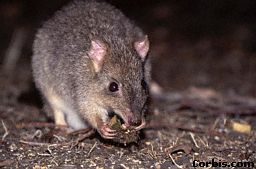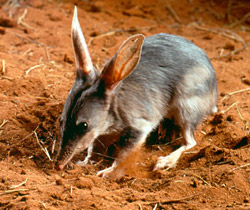
The Thylacine or Tasmanian Tiger
Image from http://www.unexplainedaustralia.com
Australia as a nation has a lot to be proud of. Pristine beaches, beautiful bush land, the Great Barrier Reef and Uluru are a few things that come to mind.
Australia also boasts the highest mammal extinction record in the world.
That is something I can say, I am not proud of.
And it’s probably something many Australians aren’t even aware of.
Twenty seven mammal species have become extinct in Australia in the last 200 years – no other country in the world has had that many mammal extinctions.
The Tasmanian tiger, desert bandicoot and brush tailed bettong are just a few species which no longer exist.
David Keith is a professor of botany at the University of New South Wales and is one of the authors of the new IUCN threatened ecosystems red list. I spoke to him about why Australia is experiencing such dramatic extinction rates.
“Two things happened,” he said.

Brush tailed bettong
Image from http://www.kidscyber.com.au
“Firstly, domestic livestock were introduced in excessive numbers and a lot of the vegetation that was cover for native animals was destroyed. The second thing that happened was that foxes and cats were introduced.”
“So the combination of reduced shelter for those animals to hide from predators and the introduction of new predators that they weren’t used to, meant that a lot of those mammal species disappeared in a very short space of time and more so than anywhere else around the world,” he explained.
We have over 1,500 mammal, bird, reptile, amphibian and plant species threatened with extinction in Australia. The Federal Government has also listed at least 3,000 ecosystems that are facing extinction.
Professor Keith attributes the endangered status of many ecosystems to land clearing – the conversion of native bush to agricultural or industrial land.
“The vast majority of the causes and the threatening processes that are driving the loss of biodiversity are related to human activities in some way,” he said.
“South west and south eastern woodlands and native grasslands for example, are in prime agricultural zones of Australia’s food production.”
Marine and freshwater ecosystems such as the Murray-Darling Basin and its major tributaries are also at risk due to water exploitation.
“There are a lot of wetlands in those areas that are in quite a bit of trouble because the water is not coming to them in the same way that they once did,” Keith said.
“It’s also about regulating the use of water. In the context of Australia’s variable climate you have to recognise that every year is not going to be a wet year and we have to plan for that.”

Desert bandicoot
Image from http://www.freewebs.com
Australia is home to more biodiversity than any other developed country on earth. It is one of the 17 ‘mega diverse’ nations along with Brazil, South Africa and Indonesia.
The majority of Australia’s species are endemic, meaning they are only found in Australia. Once they are gone, they are gone for good.
Dr. Sarah Legge from the Australian Wildlife Conservancy believes we must take urgent action now to stop further extinctions.
“It would be heart‐breaking and internationally embarrassing if we were to stand aside and witness another wave of extinctions without making any effort to intervene.”
“We need to better understand the detail of what each native mammal needs to survive,” she said.
Professor Keith agreed, “If it is business as usual, we are in for substantial losses. There are a lot of things that are only just hanging on so unless some more corrective action is taken, we are going to lose those things.”
Is the government doing enough? Keith tells me they can always do more. He also believes that some of Australia’s legislation on land clearing is not as strong as it needs to be. There are a lot of loopholes in the legislation that can allow for some inappropriate land clearance and habitat loss.
“People are probably a lot more in the dark than they should be about the state of the environment because after all, their physical, mental and economic wellbeing is really dependent on the environment,” he added.
Perhaps the problem is that we don’t hear about these issues very much. Every night there is the report on the stock market. We don’t get once a week, we don’t even get once a month, for environmental matters.

